Atlantoxerus
Atlantoxerus getulus
Barbary Ground Squirrel
Scott J. Steppan and Shawn M. HammIntroduction
The genus Atlantoxerus contains the single species Atlantoxerus getulus, the Barbary Ground Squirrel. This particular species of squirrel was first named in Africa by C. Linnaeus in 1758. By 1978, the squirrel’s location was restricted to the Barbary Coast in Northwest Africa (Corbet 1978). This is the only species of squirrel that is located north of the Sahara Desert in Africa.
The Barbary Ground Squirrel has been observed to occupy mostly rocky environments (Nowak 1999), where it creates burrows in the ground or possible dens within crevices of large rocks. Activity outside the burrow or den is limited to early morning and late afternoon due to high temperatures during the height of the day. One characteristic of these ground squirrels that distinguishes them from many other species of squirrel is their apparent food preference. The large, olive-like fruit and seeds of the Argan tree in Morocco is a primary source of food for these squirrels.

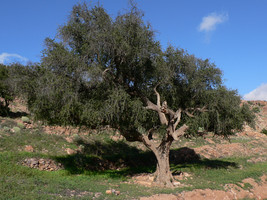
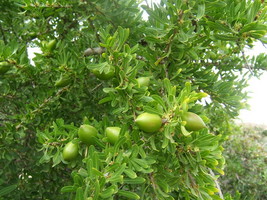
Left: An Argan tree, Argania spinosa. © 2006 Carsten Drossel. Right: The fruit of the Argan Tree.
Colonies of multiple groups or families of the squirrels are evident in areas where there is a secure food source. The squirrels have been observed to migrate when their population becomes excessive and the food source becomes scarce (Nowak 1999).
Characteristics
A. getulus is a smaller species of squirrel, with head and body length 160-220 mm, tail length 180-230 mm, and weight range of 300-350 grams (Krapp in Grzimek 1990). It has a white stripe that runs down each side of its body, with the occasional white stripe straight down the back. The fur is short and stiff.

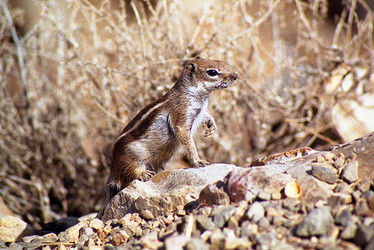
Atlantoxerus getulus. © 2006 Krista van der Voorden
Dental records of A. getulus show that it contains two premolars on both sides of the upper jaw. In many cases, the squirrel has a groove in the upper incisors (Nowak 1999).
Classification
C. Linnaeus (1758) had initially named this squirrel Sciurus getulus. The genus Atlantoxerus was established by Forsyth Major (1893). Due to this squirrel’s similar physical characteristics to those squirrels in genus Xerus, Atlantoxerus was treated as a subgenus of Xerus. Atlantoxerus was formally raised to full generic rank by Thomas (1909a) and became incorporated into the tribe Xerini by Moore (1959), within the Subfamily Xerinae (Gromov et al. 1965:70; Wilson and Reeder 2005).
Geographic Distribution
A. getulus inhabits Morocco and Algeria, countries on the north-western coast of Africa (Corbet 1978). Within this region, the squirrel has been found to occupy all areas between the Mediterranean coasts and the three ranges of the Atlas Mountains, to an elevation of more than 4,000 meters (Krapp in Grzimek 1990). In addition, the squirrel has been found on the island of Fuerteventura, located in the Canary Islands off the west coast of Morocco (Nowak 1999).
References
Corbet, G.B. 1978. The mammals of the Palaearctic Region: a taxonomic review. British Mus. (Nat. Hist.), London.
Gromov et al. 1965. Fauna SSSR. Mlekopitayushchie, Volume 3, no. 2. Ground Squirrels (Marmotinae). Nauka, Moscow-Lenningrad.
Grzimek, B., ed. 1990. Grzimek’s encyclopedia of mammals. Mc-Graw-Hill, New York, 5 vols.
Linnaeus, C. 1758. Systema Naturae per regna tria naturae, secundum classis, ordines, genera, species cum characteribus, differentiis, synonymis, locis. Tenth ed. Vol 1. Laurentii Salvii, Stockholm, 824 pp.
Forsyth Major, C.J., 1893. On some Miocene squirrels, with remarks on the dentition and classification of the Sciurinae. Proc. Zool. Soc. Lond., 179–215.
Moore, J.C. 1959. Relationships among the living squirrels of the Sciurinae. Bulletin of the American Museum of Natural History.
Nowak, N.M. Walker's Mammals of the World. 6th ed. Vol. 2. Baltimore, MD: Johns Hopkins UP, 1999.
Thomas, O. 1909. Mr. O. Thomas on the generic arrangement of the African Squirrels. Annals and Magazine of Natural History, ser. 8, 3.467-475.
Wilson, D. E., and D. M. Reeder (Eds.). 2005. Mammal Species of the World, Third Edition. Johns Hopkins University Press, Baltimore, MD.
Title Illustrations

| Scientific Name | Atlantoxerus getulus |
|---|---|
| Copyright | © 2006 Krista van der Voorden |
About This Page
Scott J. Steppan

Florida State University, Tallahassee, Florida, USA

Florida State University, Tallahassee, Florida, USA
Correspondence regarding this page should be directed to Scott J. Steppan at and Shawn M. Hamm at
Page copyright © 2006 Scott J. Steppan and
All Rights Reserved.
- First online 24 October 2006
- Content changed 30 October 2006
Citing this page:
Steppan, Scott J. and Shawn M. Hamm. 2006. Atlantoxerus. Atlantoxerus getulus. Barbary Ground Squirrel. Version 30 October 2006 (under construction). http://tolweb.org/Atlantoxerus_getulus/16819/2006.10.30 in The Tree of Life Web Project, http://tolweb.org/




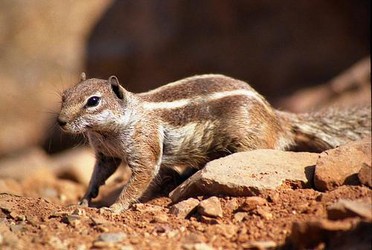
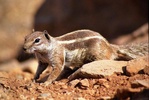


 Go to quick links
Go to quick search
Go to navigation for this section of the ToL site
Go to detailed links for the ToL site
Go to quick links
Go to quick search
Go to navigation for this section of the ToL site
Go to detailed links for the ToL site